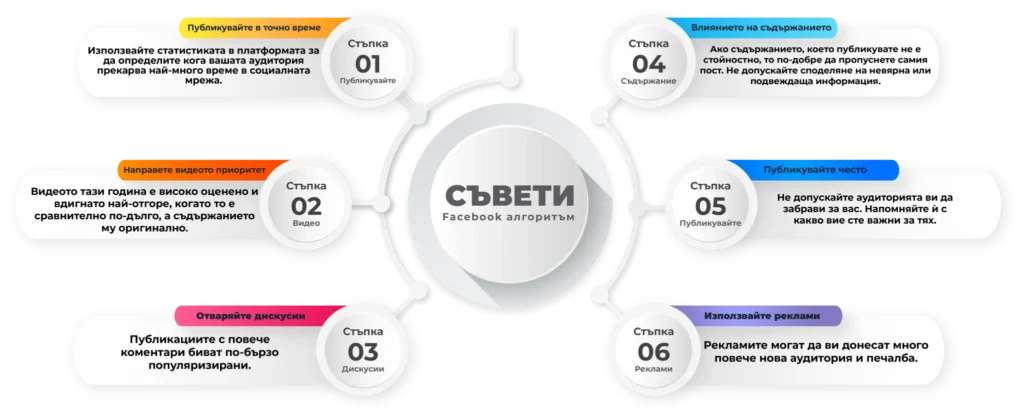Learn about the Facebook algorithm

Make the Facebook algorithm your ally
Imagine that Facebook’s algorithm is a constantly updated map of a messy forest. If you can’t read this guide or use your old knowledge of it, you risk quickly depleting all your provisions in a blind attempt to find the exact place you’re looking for, or if you do manage to find it, it will cost you an unforgivable amount of energy and time that you won’t be able to get back. In this case, our map, the algorithm we’re talking about, would play an important role in drawing up a precise plan of action, which would save us resources, time and effort. In short – with this map, you will be able to cross the forest on the most direct and easiest path for you, which will lead you to the right place. Sounds promising, right?
Of course, in order for everyone to make the most of this map, they must first learn to read it. And then develop the habit of monitoring its new variations. So let's start talking about the essence of the Facebook algorithm, the importance of which we have already understood.
The last update of the algorithm was at the beginning of 2020. As if anticipating all the major changes in the world, it also decided to introduce a new version of it.

But when did the first Facebook algorithm actually appear?
The platform appeared in 2004, but it was not until 2009, when the "Like" button was created, that it began to resemble what we know today. That's when the first algorithm appeared to display more popular publications first, rather than the newest ones. Since then, Facebook has been changing its algorithm so that its users spend more and more time on it, since longer use equals more ads, which in turn equals more revenue for the platform.
For example, one of the first changes to Facebook's algorithm was from 2014, when the platform began to place posts below, inviting users for one reason or another to like them, in other words clickbait - a good example are photos with captions "Like for luck", etc. Also this year, Facebook began to collect information from its users on how long they watch a video uploaded directly to the platform, helping it to suggest posts similar to our interests. Then the platform also began to place shared publications above, the links of which were the most read.
We probably all remember the moment in 2015 г., when all the pages on Facebook were competing to invite their audience to put them on their “See First” list. This year, the platform also took a stand against fake news by placing posts marked as fake lower. Also, the viewability of Facebook stories is starting to influence the posts we see.
In 2016 the platform pays attention to the close circle of its users, bringing them to the forefront, as well as showing the publications that are spent more time on even without liking them. In addition, Facebook is also betting on its "Live" feature, which according to statistics generates 3 times more views than a regular video.
In 2017 the familiar reactions appear, and links to articles with overly exclusive and false headlines start appearing further down. Also an interesting change is the ban on pages spreading fake news from purchasing ads on the platform.
In 2018 the platform is starting to promote publications that provoke more interest and discussion, and such value-distributing links with information.
In 2019 Facebook is introducing a “Why am I seeing this?” button to help users understand how the platform’s algorithm works, as well as options to no longer see posts from a user or page or to temporarily mute them. Facebook is also getting even closer to its users by asking them questions that help the algorithm work with their interests.
In 2020 the changes are also noticeable. Videos are being pushed higher when they are original content and longer than a minute, and penalties will be placed on pages using clickbait. In addition, Facebook groups and their content are at the forefront this year. But undoubtedly the best new feature of the platform is paid online events.

Here are some tips on how to use Facebook's algorithm:
1. Post at the right time
Use the platform's statistics to determine when your audience spends the most time on the social network. Post then so your information can reach the most people.
2. Make video a priority
As we explained above, this year's video is highly appreciated and raised to the top when it is relatively longer and its content is original.
3. Open discussions
Posts with more comments are promoted faster.
4. Don't underestimate the impact of the content of your posts
If the content you post is not valuable, it is better to skip the post itself. Do not allow sharing of false or misleading information.
5. Post often
Don't let your audience forget about you. Remind them why you are important to them.
6. Groups are important
Try creating a group based on your page. It opens up a space for more discussion and connecting your audience as a whole.
7. Use ads
Ads can bring you much more new audience and profit.
8. Remind your audience to prioritize you
Invite them to include your page in their "See First" list, which will provide you with greater visibility for your posts.
More from the blog
Are you ready for digital transformation? A new program with up to 70% European funding is coming soon.
Did you know that a new program is launching very soon that can help your business go digital and move to the next level?
SFC and Server1 – rented servers for your business!
In the modern digital environment, all companies, regardless of their activity or scale, need a stable, secure, and easily manageable IT infrastructure.
New Business Opportunities at Sales Club Conference 2025 – Vol.4
If you want to reach new heights in sales and marketing, Sales Club Conference 2025 – Vol.4 is the event you should not miss. It is a unique opportunity
Are you ready for digital transformation? A new program with up to 70% European funding is coming soon.
Did you know that a new program is launching very soon that can help your business go digital and move to the next level?
SFC and Server1 – rented servers for your business!
In the modern digital environment, all companies, regardless of their activity or scale, need a stable, secure, and easily manageable IT infrastructure.
New Business Opportunities at Sales Club Conference 2025 – Vol.4
If you want to reach new heights in sales and marketing, Sales Club Conference 2025 – Vol.4 is the event you should not miss. It is a unique opportunity




